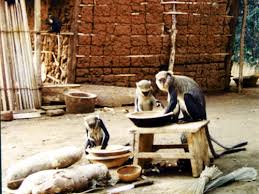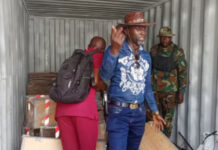
HIDDEN TREASURES OF THE GOLD COAST
…A LOOK AT GHANA’S UNTAPPED RESOURCES
“Travel makes one modest. You see what a tiny place you occupy in the world.”
Gustave Flaubert
This week’s attraction, yet again, combines the chills of myths and the beauty of nature into a beautiful blend that would excite not only tourists but anyone interested.
As usual, there is a visitor account section that would give you a first-hand experience of the tourist site and any other information you may need.
This week’s tourist attraction is more of an enactment of a story or folk tale rather than the description of a tourist attraction. So as is done in our traditional communities, have a seat and let us tell you the story of the harmony between man and monkeys. Once upon a time…
Boabeng- Fiema Monkey Sanctuary is located between Techiman and Kintampo in the Brong-Ahafo Region of Ghana. It is Ghana’s most distinguished example of traditional African conservation. People who do not believe in traditional African religion may see the conservation practices of the people as unscientific, but in Africa and elsewhere, where myths and taboos are common, the story of Boaben-Fiema is a beautiful one.
It is a widely held belief that anybody that intentionally kills a monkey suffers a calamity and there are countless stories of families that have been wiped out because one of them intentionally killed a monkey. To add to the taboos and myths, farming on Fridays have been barred in reverence to the monkeys.

The dense tropical forest at the outskirts of the two towns is home to a host of playful and friendly monkeys of all kinds. The sanctuary is nestled in between the two villages of Boabeng and Fiema. In these two villages, monkeys and humans co-exist in the heart of a beautiful forest reserve.
For more than 150 years, the people of Boabeng and Fiema have considered the monkeys sacred and as such revere their presence. Local folklore has it that a hunter came into contact with a spirit being called Daworo. A relationship developed between them and to ground this relationship, Daworo presented the hunter with a surprise. On one of his numerous visits to the forest in pursuit of his chosen profession, he found some monkeys who had gathered around a pot covered with a white cloth.
The farmer did not know what to do with what he had seen and decided to consult the Daworo who told the farmer to take the white cloth back home with him. To his surprise the monkeys followed him home. It is believed that Daworo told the farmer not kill the monkeys but treat them as relations. Since then, the two (man and monkey) have coexisted as one happy family.
The sanctuary is home to over 200 black and white (leaves, stems and mineralized earth eating) Colobus and 500 brown colour flowers, fruits and insect eating Campbell’s Mona Monkeys. As the names suggest, these monkeys are named after people who discovered them or have contributed to unearthing them.
The early hours and late evenings are the ideal periods in the day that these monkeys can be easily spotted. Visitors can hear the monkeys shout loudly in calling their troupe members. They come so close to human beings that it is not surprising to find monkeys trying to steal food from local kitchens.
They are not harmed by the locals because according to tradition, anyone who harms them will suffer some form of calamity and more so because locals consider the monkeys their relatives; that is if the story of the hunter and the spirit being is anything to go by.
This has given the monkeys some form of freedom that is not seen anywhere. This has made Boabeng-Fiema Monkey Sanctuary one of the few unique places to visit. A place where African mythology coupled with sound scientific management of wildlife has contributed to the conservation of these species of monkey.
Features of the Monkey Sanctuary
If the Hindus of India have reverence for their cows, then, the people of Boaben-Fiema have stepped it up more than notch. At Boabeng-Fiema monkey sanctuary, one thing that grasps your attention is the cemetery where monkeys have been buried over the years.

There are graves bearing inscriptions of the types of monkeys and the dates they died. The well-educated local tour guides are on hand to give a full account of how the burial is done. The narrative given includes what the monkeys are put in before burial (just falling short of saying a casket) and what they are wrapped in before burial- a white cloth for sure.
The cemetery has quite a lot of graves at present. It is believed that monkeys from the two villages who are about to die will always make the journey back home to the sanctuary before dying.
The forest that makes the sanctuary also distinguishes itself with beautiful plant species, mainly, climbers which enable monkeys to swing and jump from tree to tree. The excellent walking trails cannot be left out when talking about Boabeng-Fiema; this allows you and your tour guide to hike in the forest and observe the monkeys from all angles either in the day or night.
The monkeys are easy to see if you walk through the forest or the village and the guides are very well-informed regarding the monkey clans and the areas they like to hang out.
The forest is also home to a variety of butterflies, birds, and over 90 identified species of trees.
For those interested in locally produced souvenir, there is a shop in the village of Boabeng, where you can get access to carvings of ebony, cedar and mahogany by locals along with some antique traditional beads and locally made jewellery. Crafts of the different types of monkeys mentioned can be purchased from these souvenir shops.
One important thing worth mentioning is the hospitality of the indigenous people. The people are so welcoming that all visitors, to the community, are treated as family. Anyone you come into contact with will know whether you are a stranger and for that matter have come to them because of their “brothers”, the monkeys. In view of this, all necessary courtesies are extended to you even if you are there not because of the monkeys.
Visitors are however advised not to feed the monkeys just anything. The reasons for such a prohibition are engraved in sound botany and wildlife practices across the world. If you want to feed them and are not sure of what to offer, just ask any of the tour guides around.
Visitor Account
The Ashanti region is close to the equally marvellous Brong-Ahafo region, full with rainforests and amazing landscape. It is also the home of the famous Boabeng-Fiema Monkey Sanctuary.
The people in Boabeng and Fiema consider the monkeys to be sacred and in the 70s actually came together to pass a law prohibiting causing harm to the monkeys. The story goes that a hunter in Boabeng came across some monkeys guarding a piece of calico. He consulted his spirit Daworoh and was told that these monkeys would bring him good fortune. The hunter took the calico to his village and the monkeys followed him there, and since then the monkeys have lived in harmony with human beings.
The sanctuary holds about 400 monkeys – Colobus and Mona monkeys. The Colobus monkeys are vegetarians and do not come down to the ground often, but the Mona monkeys come down all the time and eat bread, nuts and a lot of things humans have to offer. They come into the village all the time to steal things, but as the people are not allowed to hurt them, they simply get away with it!
It was simply amazing to have the Mona monkeys come up to me and take food off my hands. They are not scared at all and fully expect to be given something. They are still wild monkeys which is the amazing thing! The guide told me that in all her years, there had not been one day that she did not see the monkeys. There is also a monkey cemetery in the forest, where the priests of the village have been buried with other monkeys that have passed away.
Volunteers, especially in Kumasi should take this trip up to Boabeng-Fiema and they will not be disappointed. This trip can easily be done in conjunction with visiting the Kintampo Falls and still come back on the same day.
Entry fees
Ghanaian adults Gh¢ 2.00,
Ghanaian students Gh¢ 1.00
Foreign adults Gh¢ 7.00
Foreign students Gh¢ 4.00
How to get there
Travelling to Boabeng-Fiema is not a big task. The distance is about 165km north of Kumasi and just 20km from Techiman. One can easily reach this place as it is connected by a good road network.
From the capital Accra, you can either go by air with an inter-city link fight to Tamale or board a trotro or rent a taxi to Boaben-Fiema. Cost of intra-flight to Tamale ranges between Gh¢ 100 and Gh¢ 200.
You can also choose to go by a rented car, trotro (relatively cheaper than rented cars) or STC, from Accra through Kumasi to Techiman.
You may also board a trotro or taxi from the Techiman main lorry station to the sanctuary. Accessibility is easy and convenient. The sanctuary has an accommodation facility for those who may wish to stay overnight.
Credit
Dear Ghana
Visitor account info: mytripblog.org






























